ECO mode MAZDA MODEL 3 HATCHBACK 2012 (in English) User Guide
[x] Cancel search | Manufacturer: MAZDA, Model Year: 2012, Model line: MODEL 3 HATCHBACK, Model: MAZDA MODEL 3 HATCHBACK 2012Pages: 525, PDF Size: 5.95 MB
Page 161 of 525
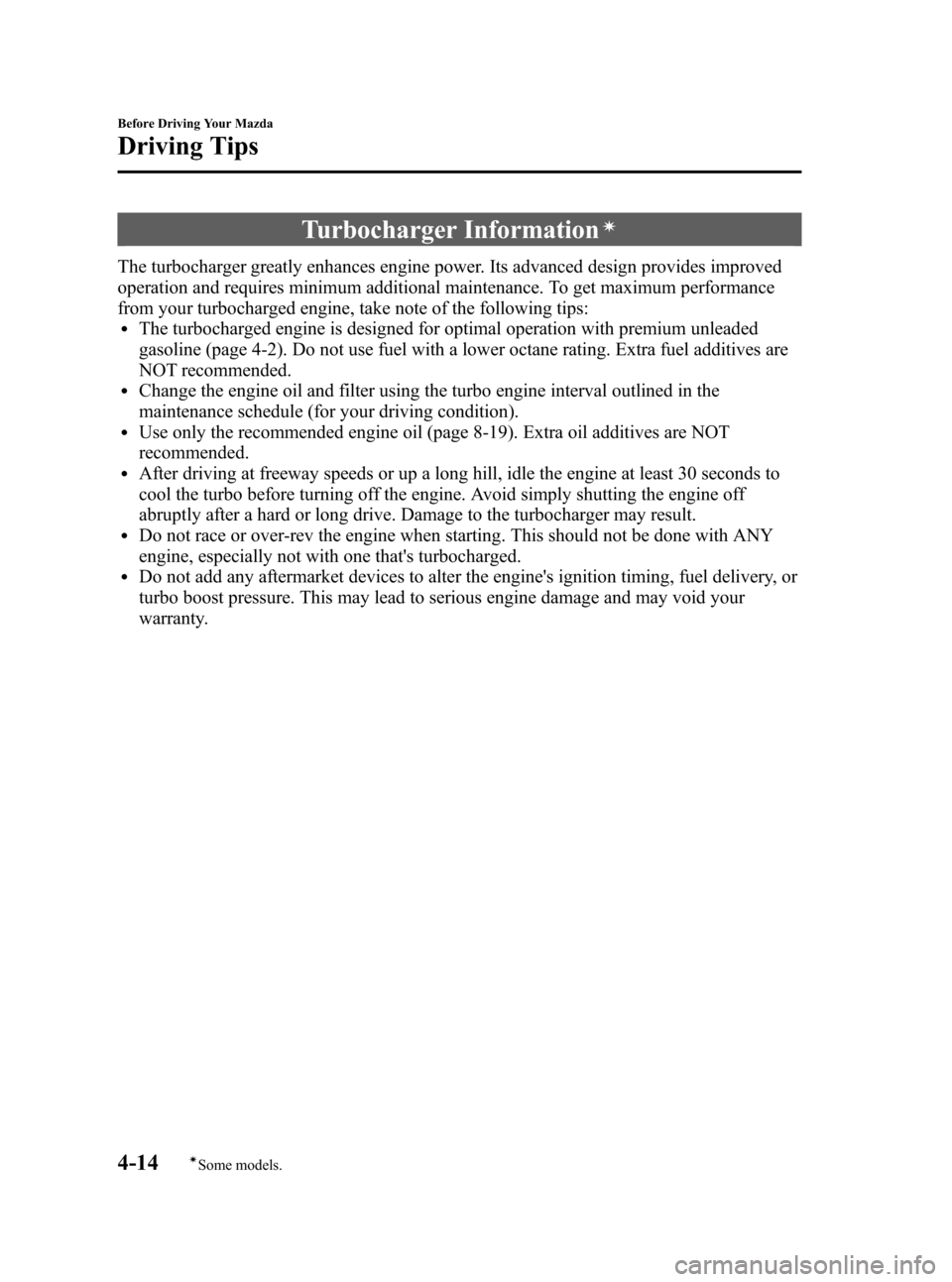
Black plate (160,1)
Turbocharger Informationí
The turbocharger greatly enhances engine power. Its advanced design provides improved
operation and requires minimum additional maintenance. To get maximum performance
from your turbocharged engine, take note of the following tips:
lThe turbocharged engine is designed for optimal operation with premium unleaded
gasoline (page 4-2). Do not use fuel with a lower octane rating. Extra fuel additives are
NOT recommended.
lChange the engine oil and filter using the turbo engine interval outlined in the
maintenance schedule (for your driving condition).
lUse only the recommended engine oil (page 8-19). Extra oil additives are NOT
recommended.
lAfter driving at freeway speeds or up a long hill, idle the engine at least 30 seconds to
cool the turbo before turning off the engine. Avoid simply shutting the engine off
abruptly after a hard or long drive. Damage to the turbocharger may result.
lDo not race or over-rev the engine when starting. This should not be done with ANY
engine, especially not with one that's turbocharged.
lDo not add any aftermarket devices to alter the engine's ignition timing, fuel delivery, or
turbo boost pressure. This may lead to serious engine damage and may void your
warranty.
4-14
Before Driving Your Mazda
íSome models.
Driving Tips
Mazda3_8BY7-EC-11F_Edition1 Page160
Friday, June 17 2011 2:55 PM
Form No.8BY7-EC-11F
Page 180 of 525

Black plate (179,1)
NOTElIf the gears cannot be shifted down when
driving at higher speeds, the gear position
indicator will flash twice to signal that the
gears cannot be shifted down (to protect the
transaxle).
lIf the automatic transaxle fluid (ATF)
temperature becomes too high, there is the
possibility that the transaxle will switch to
automatic shift mode, canceling manual
shift mode and turning off the gear position
indicator illumination. This is a normal
function to protect the AT. After the ATF
temperature has decreased, the gear
position indicator illumination turns back
on and driving in manual shift mode is
restored.
Shifting
Manually Shifting up
(M1→M2 →M3 →M4 →M5 →
M6
í)
To shift up to a higher gear, tap the shift
lever back (
) once.
NOTElWhen driving slowly, the gears may not
shift up.
lIn manual shift mode, gears do not shift up
automatically. Do not run the engine with
the tachometer needle in the RED ZONE. If
the tachometer needle enters the RED
ZONE, you may feel engine-braking
because the fuel delivery will be stopped to
protect the engine. However, this does not
indicate an abnormality.
lWhen depressing the accelerator fully, the
transaxle will shift to a lower gear,
depending on vehicle speed (Except M2 →
M1).
Manually Shifting down
(M6
í→ M5 →M4 →M3 →M2 →
M1)
To shift down to a lower gear, tap the shift
lever forward (
) once.
Driving Your Mazda
Starting and Driving
5-17íSome models.
Mazda3_8BY7-EC-11F_Edition1 Page179
Friday, June 17 2011 2:55 PM
Form No.8BY7-EC-11F
Page 181 of 525

Black plate (180,1)
WARNING
Do not use engine braking on slippery
road surfaces or at high speeds:Shifting down while driving on wet,
snowy, or frozen roads, or while
driving at high speeds causes sudden
engine braking, which is dangerous.
The sudden change in tire speed
could cause the tires to skid. This
could lead to loss of vehicle control
and an accident.
NOTE
lWhen driving at high speeds, the gear may
not shift down.
lDuring deceleration, the gear may
automatically shift down depending on
vehicle speed.
lWhen depressing the accelerator fully, the
transaxle will shift to a lower gear,
depending on vehicle speed (Except M2 →
M1).
Second gear fixed mode
When the shift lever is tapped back (
)
while the vehicle is stopped or driven at
the following speeds, the transaxle is set
in the second gear fixed mode.
SKYACTIV-G 2.0 model:
10.1 km/h (6.27 mph) or less
MZR 2.0, MZR 2.5 model:
12 km/h (7.5 mph) or less
The gear is fixed in second while in this
mode for easier starting and driving on
slippery roads. If the shift lever is tapped
back (
) or forward () while in the
second gear fixed mode, the mode will be
canceled.
Shifting specification
Shifting up
If the vehicle speed is lower than the
speed specified for each gear, the gear
cannot be shifted up to a higher gear.
(MZR 2.0)
Gear Vehicle speed
M1 →M2 You can shift up to M2 whether the
vehicle is stopped or moving.
M2 →M3 20.5 km/h (12.8 mph)
M3 →M4
37 km/h (23 mph)
M4 →M5
(SKYACTIV-G 2.0) Gear Vehicle speed
M1 →M2 10.1 km/h (6.28 mph)
M2 →M3 25.6 km/h (16.0 mph)
M3 →M4 35.2 km/h (21.9 mph)
M4 →M5 55 km/h (35 mph)
M5 →M6 70 km/h (44 mph)
(MZR 2.5) Gear Vehicle speed
M1 →M2 You can shift up to M2 whether the
vehicle is stopped or moving.
M2 →M3 20.5 km/h (12.8 mph)
M3 →M4
34 km/h (22 mph)
M4 →M5
Shifting down
If the vehicle speed is higher than the
speed specified for each gear, the gear
cannot be shifted to a lower gear so as to
protect the transaxle.
(MZR 2.0)
Gear Vehicle speed
M5 →M4 213 km/h (132 mph)
M4 →M3 153 km/h (95 mph)
M3 →M2 100 km/h (62 mph)
M2 →M1 40 km/h (24 mph)
5-18
Driving Your Mazda
Starting and Driving
Mazda3_8BY7-EC-11F_Edition1 Page180
Friday, June 17 2011 2:55 PM
Form No.8BY7-EC-11F
Page 182 of 525

Black plate (181,1)
(SKYACTIV-G 2.0)Gear Vehicle speed
M6 →M5 271.1 km/h (168.4 mph)
M5 →M4 192 km/h (119 mph)
M4 →M3 132.2 km/h (82.14 mph)
M3 →M2 94.9 km/h (58.9 mph)
M2 →M1 54 km/h (33 mph)
(MZR 2.5)
Gear Vehicle speed
M5 →M4 196 km/h (121 mph)
M4 →M3 135 km/h (83 mph)
M3 →M2 90 km/h (55 mph)
M2 →M1 37 km/h (22 mph)
NOTE
Regarding the vehicle speed at the highest
gear indicated above, achieving this speed
may not actually be possible depending on
various driving conditions such as the wind,
upslope, and road surface.
During deceleration, the gears shift down
automatically when speed is reduced to
the following:
(SKYACTIV-G 2.0)
Gear Vehicle speed
M6 →M5 66.8 km/h (41.5 mph)
M5 →M4 53 km/h (32 mph)
M4 →M3 32 km/h (19 mph)
M3 →M2 13.7 km/h (8.51 mph)
M2 →M1 7.1 km/h (4.4 mph)
(MZR 2.0, MZR 2.5) Gear Vehicle speed
M5 or M4 →
M3 31 km/h (19 mph)
M3 or M2 →
M1 10 km/h (6 mph)
NOTE
The gear does not shift down to M1
automatically while in the second gear fixed
mode.
If the vehicle is kicked down at the
following speeds or lower, the gears shift
down automatically:
(MZR 2.0)
Gear Vehicle speed
M5 →M4 199 km/h (123 mph)
M4 →M3 146 km/h (90 mph)
M3 →M2 54 km/h (33 mph)
(SKYACTIV-G 2.0) Gear Vehicle speed
M6 →M5 248.5 km/h (154.4 mph)
M5 →M4 160 km/h (99.4 mph)
M4 →M3 66.1 km/h (41.0 mph)
M3 →M2 47.4 km/h (29.4 mph)
(MZR 2.5) Gear Vehicle speed
M5 →M4 183 km/h (113 mph)
M4 →M3 126 km/h (78 mph)
M3 →M2 51 km/h (31 mph)
Recommendations for shifting
Upshifting
For normal acceleration and cruising, we
recommend these shift points.
(SKYACTIV-G 2.0)
Gear Vehicle speed
M1 to M2 24 km/h (15 mph)
M2 to M3 40 km/h (25 mph)
M3 to M4 65 km/h (40 mph)
M4 to M5 73 km/h (45 mph)
M5 to M6 81 km/h (50 mph)
(MZR 2.0, MZR 2.5) Gear Vehicle speed
M1 to M2 24 km/h (15 mph)
M2 to M3 40 km/h (25 mph)
M3 to M4 65 km/h (40 mph)
M4 to M5 73 km/h (45 mph)
Driving Your Mazda
Starting and Driving
5-19
Mazda3_8BY7-EC-11F_Edition1 Page181
Friday, June 17 2011 2:55 PM
Form No.8BY7-EC-11F
Page 184 of 525
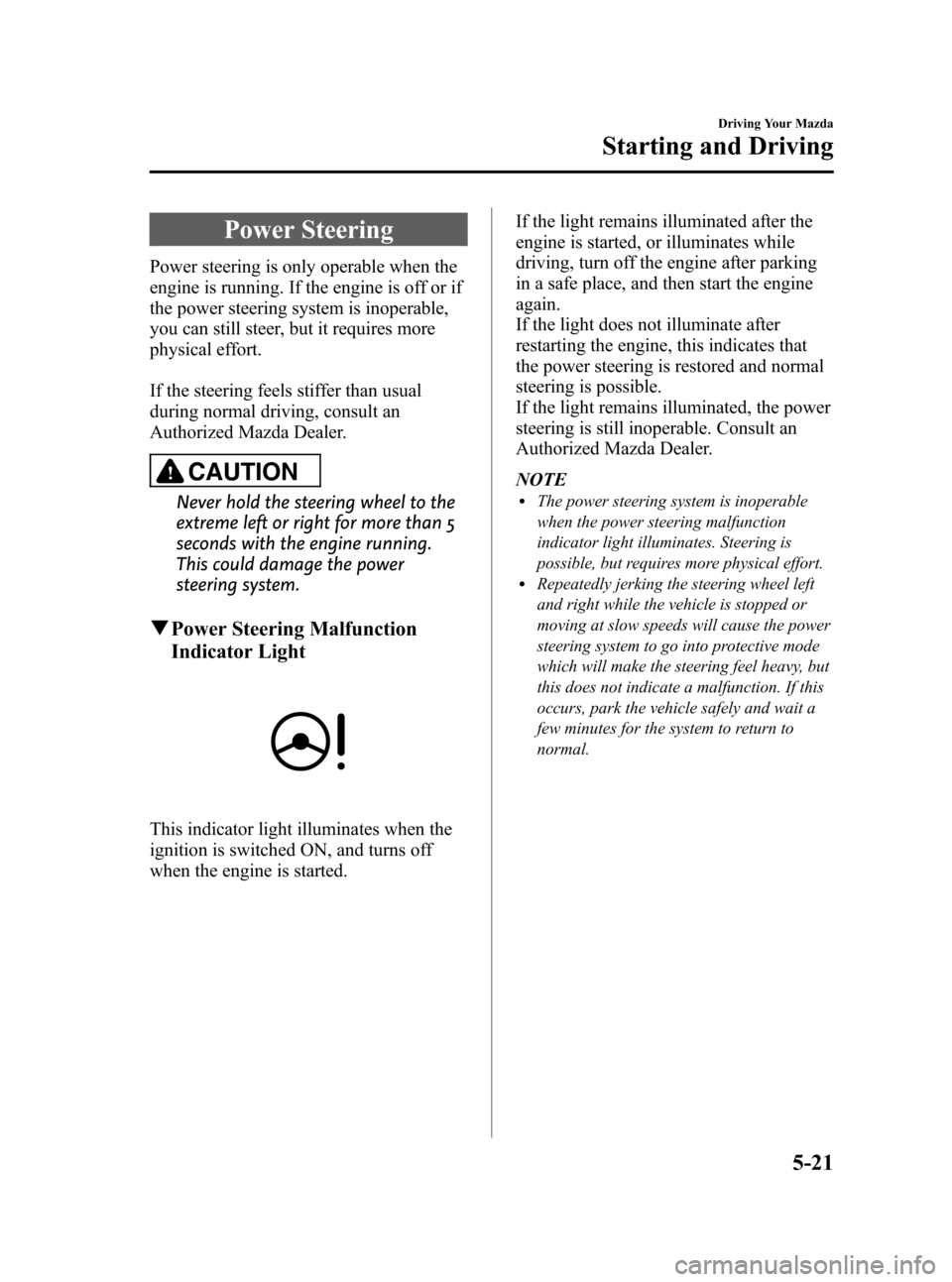
Black plate (183,1)
Power Steering
Power steering is only operable when the
engine is running. If the engine is off or if
the power steering system is inoperable,
you can still steer, but it requires more
physical effort.
If the steering feels stiffer than usual
during normal driving, consult an
Authorized Mazda Dealer.
CAUTION
Never hold the steering wheel to the
extreme left or right for more than 5
seconds with the engine running.
This could damage the power
steering system.
qPower Steering Malfunction
Indicator Light
This indicator light illuminates when the
ignition is switched ON, and turns off
when the engine is started. If the light remains illuminated after the
engine is started, or illuminates while
driving, turn off the engine after parking
in a safe place, and then start the engine
again.
If the light does not illuminate after
restarting the engine, this indicates that
the power steering is restored and normal
steering is possible.
If the light remains illuminated, the power
steering is still inoperable. Consult an
Authorized Mazda Dealer.
NOTE
lThe power steering system is inoperable
when the power steering malfunction
indicator light illuminates. Steering is
possible, but requires more physical effort.
lRepeatedly jerking the steering wheel left
and right while the vehicle is stopped or
moving at slow speeds will cause the power
steering system to go into protective mode
which will make the steering feel heavy, but
this does not indicate a malfunction. If this
occurs, park the vehicle safely and wait a
few minutes for the system to return to
normal.
Driving Your Mazda
Starting and Driving
5-21
Mazda3_8BY7-EC-11F_Edition1 Page183
Friday, June 17 2011 2:55 PM
Form No.8BY7-EC-11F
Page 191 of 525
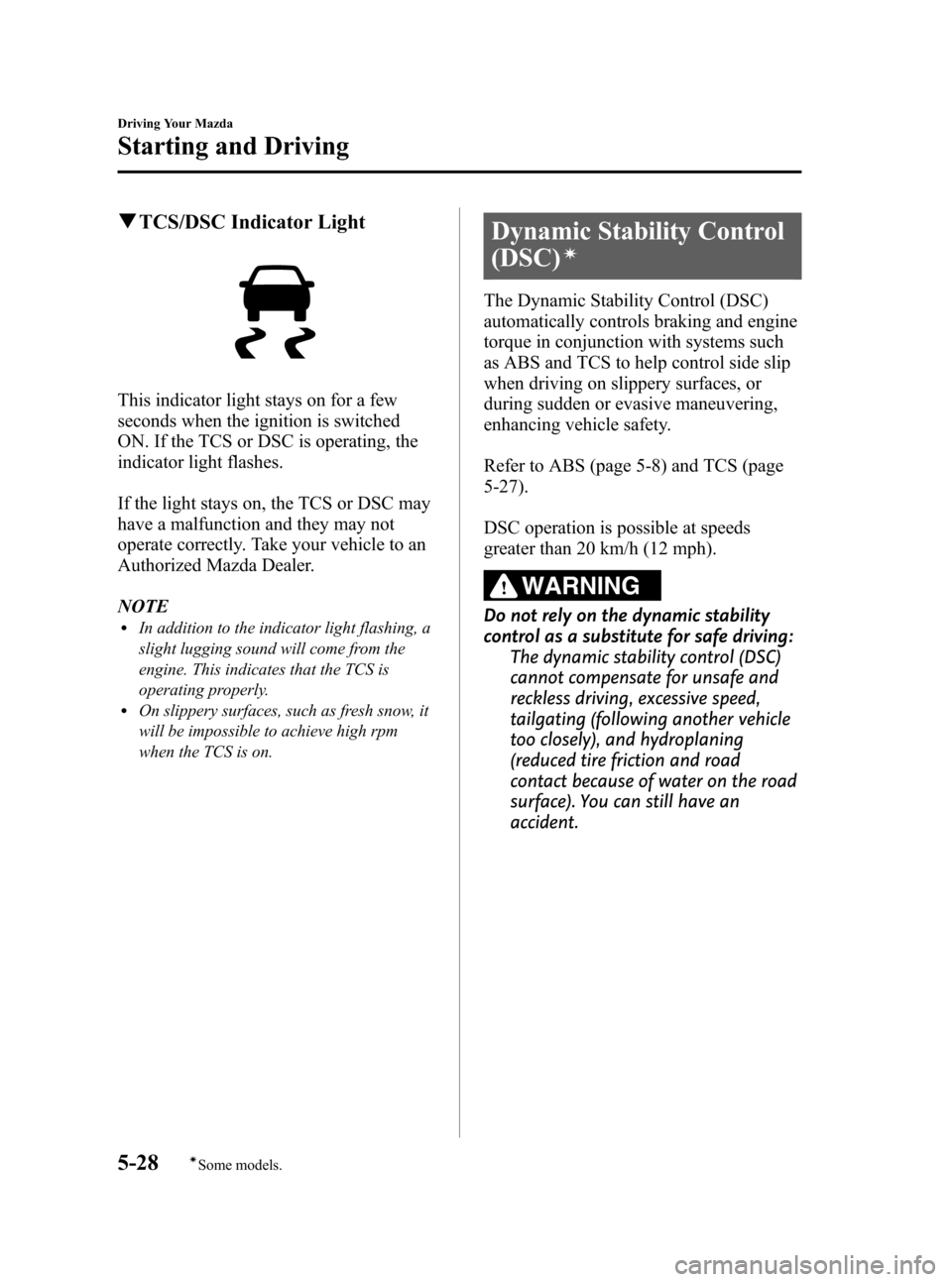
Black plate (190,1)
qTCS/DSC Indicator Light
This indicator light stays on for a few
seconds when the ignition is switched
ON. If the TCS or DSC is operating, the
indicator light flashes.
If the light stays on, the TCS or DSC may
have a malfunction and they may not
operate correctly. Take your vehicle to an
Authorized Mazda Dealer.
NOTE
lIn addition to the indicator light flashing, a
slight lugging sound will come from the
engine. This indicates that the TCS is
operating properly.
lOn slippery surfaces, such as fresh snow, it
will be impossible to achieve high rpm
when the TCS is on.
Dynamic Stability Control
(DSC)
í
The Dynamic Stability Control (DSC)
automatically controls braking and engine
torque in conjunction with systems such
as ABS and TCS to help control side slip
when driving on slippery surfaces, or
during sudden or evasive maneuvering,
enhancing vehicle safety.
Refer to ABS (page 5-8) and TCS (page
5-27).
DSC operation is possible at speeds
greater than 20 km/h (12 mph).
WARNING
Do not rely on the dynamic stability
control as a substitute for safe driving:
The dynamic stability control (DSC)
cannot compensate for unsafe and
reckless driving, excessive speed,
tailgating (following another vehicle
too closely), and hydroplaning
(reduced tire friction and road
contact because of water on the road
surface). You can still have an
accident.
5-28
Driving Your Mazda
íSome models.
Starting and Driving
Mazda3_8BY7-EC-11F_Edition1 Page190
Friday, June 17 2011 2:55 PM
Form No.8BY7-EC-11F
Page 194 of 525
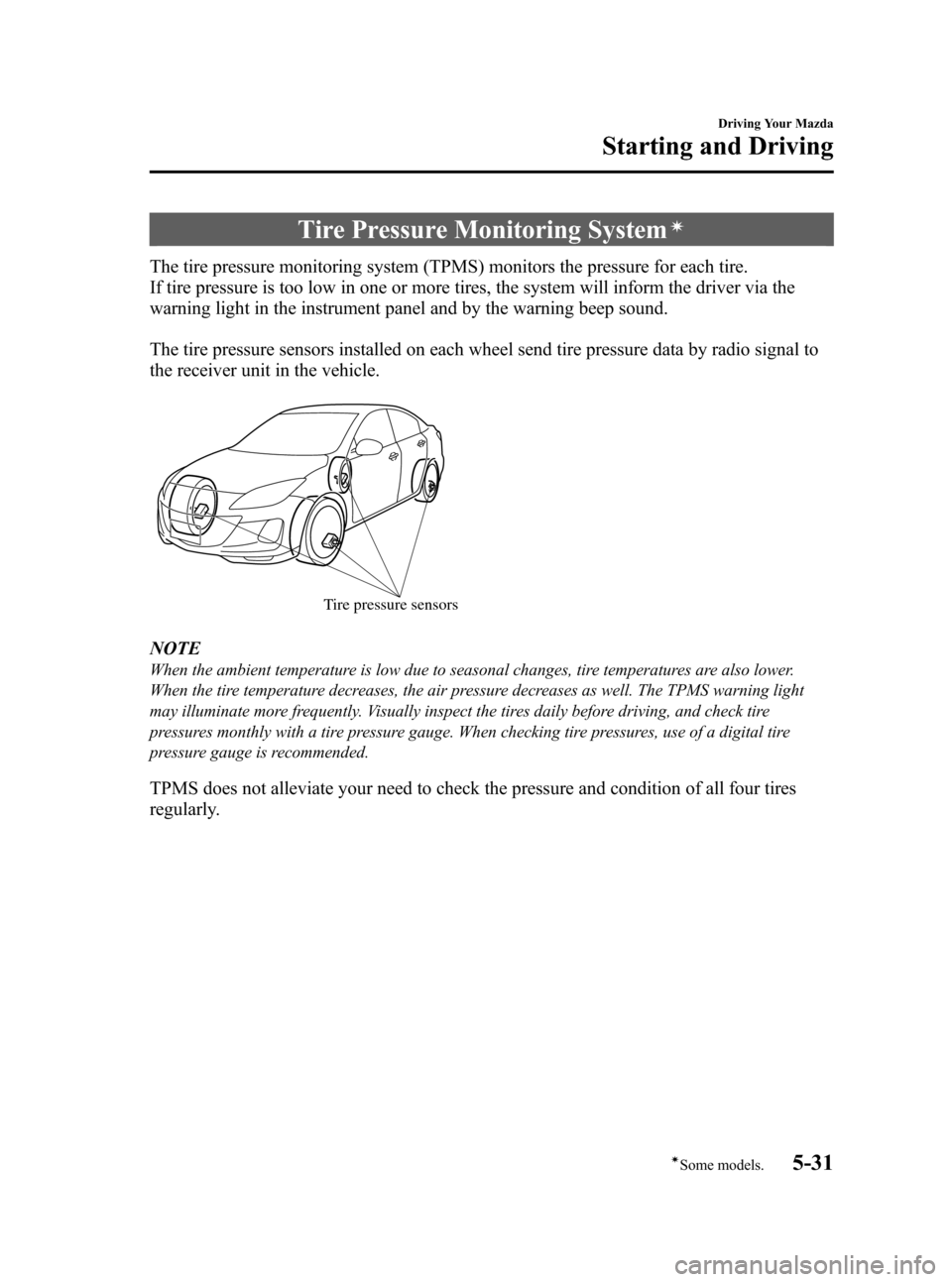
Black plate (193,1)
Tire Pressure Monitoring Systemí
The tire pressure monitoring system (TPMS) monitors the pressure for each tire.
If tire pressure is too low in one or more tires, the system will inform the driver via the
warning light in the instrument panel and by the warning beep sound.
The tire pressure sensors installed on each wheel send tire pressure data by radio signal to
the receiver unit in the vehicle.
Tire pressure sensors
NOTE
When the ambient temperature is low due to seasonal changes, tire temperatures are also lower.
When the tire temperature decreases, the air pressure decreases as well. The TPMS warning light
may illuminate more frequently. Visually inspect the tires daily before driving, and check tire
pressures monthly with a tire pressure gauge. When checking tire pressures, use of a digital tire
pressure gauge is recommended.
TPMS does not alleviate your need to check the pressure and condition of all four tires
regularly.
Driving Your Mazda
Starting and Driving
5-31íSome models.
Mazda3_8BY7-EC-11F_Edition1 Page193
Friday, June 17 2011 2:55 PM
Form No.8BY7-EC-11F
Page 206 of 525
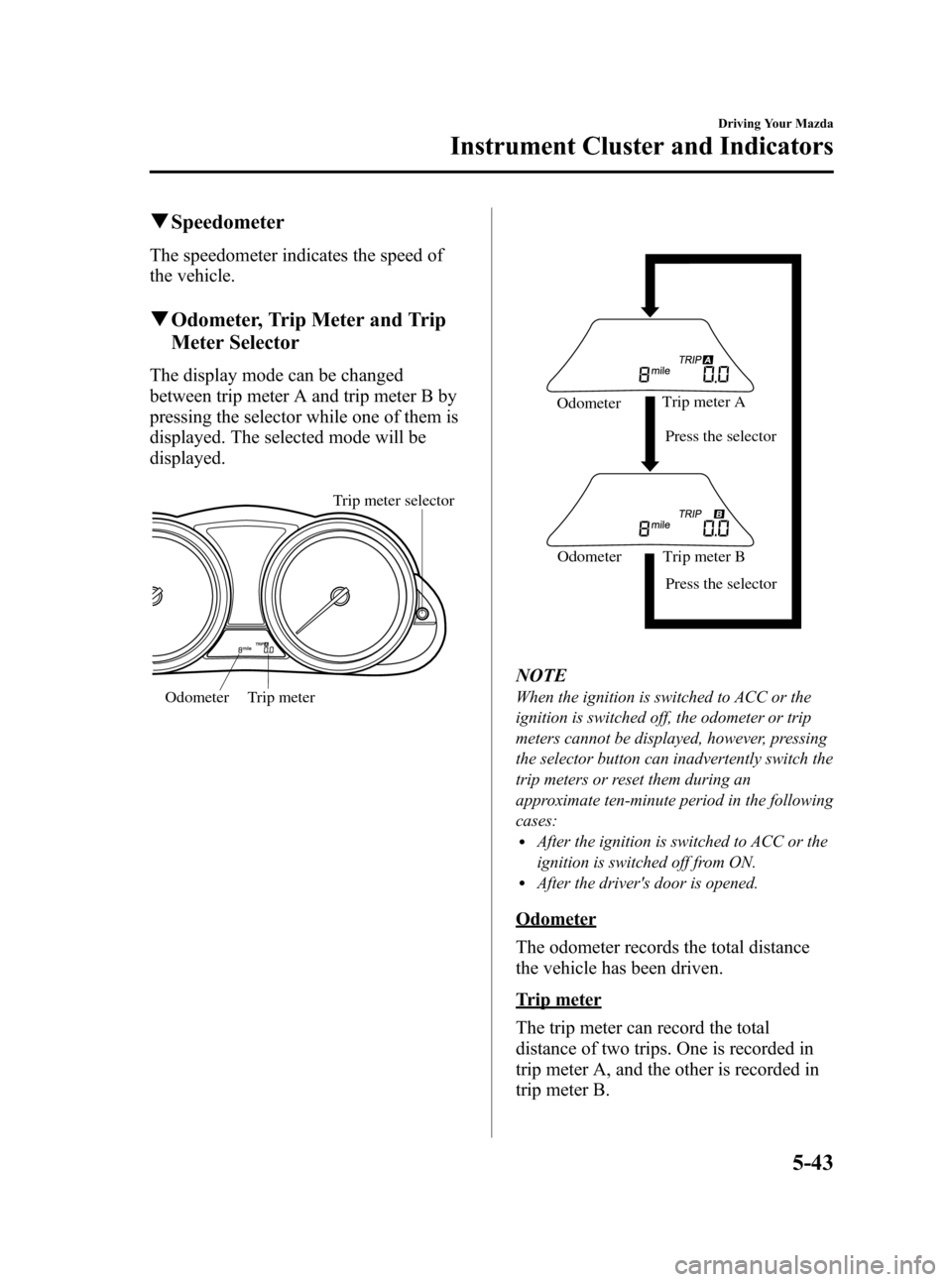
Black plate (205,1)
qSpeedometer
The speedometer indicates the speed of
the vehicle.
qOdometer, Trip Meter and Trip
Meter Selector
The display mode can be changed
between trip meter A and trip meter B by
pressing the selector while one of them is
displayed. The selected mode will be
displayed.
Trip meter
Trip meter selector
Odometer
Trip meter B
Press the selector
Press the selector
Trip meter A
Odometer
Odometer
NOTE
When the ignition is switched to ACC or the
ignition is switched off, the odometer or trip
meters cannot be displayed, however, pressing
the selector button can inadvertently switch the
trip meters or reset them during an
approximate ten-minute period in the following
cases:
lAfter the ignition is switched to ACC or the
ignition is switched off from ON.
lAfter the driver's door is opened.
Odometer
The odometer records the total distance
the vehicle has been driven.
Trip meter
The trip meter can record the total
distance of two trips. One is recorded in
trip meter A, and the other is recorded in
trip meter B.
Driving Your Mazda
Instrument Cluster and Indicators
5-43
Mazda3_8BY7-EC-11F_Edition1 Page205
Friday, June 17 2011 2:55 PM
Form No.8BY7-EC-11F
Page 207 of 525
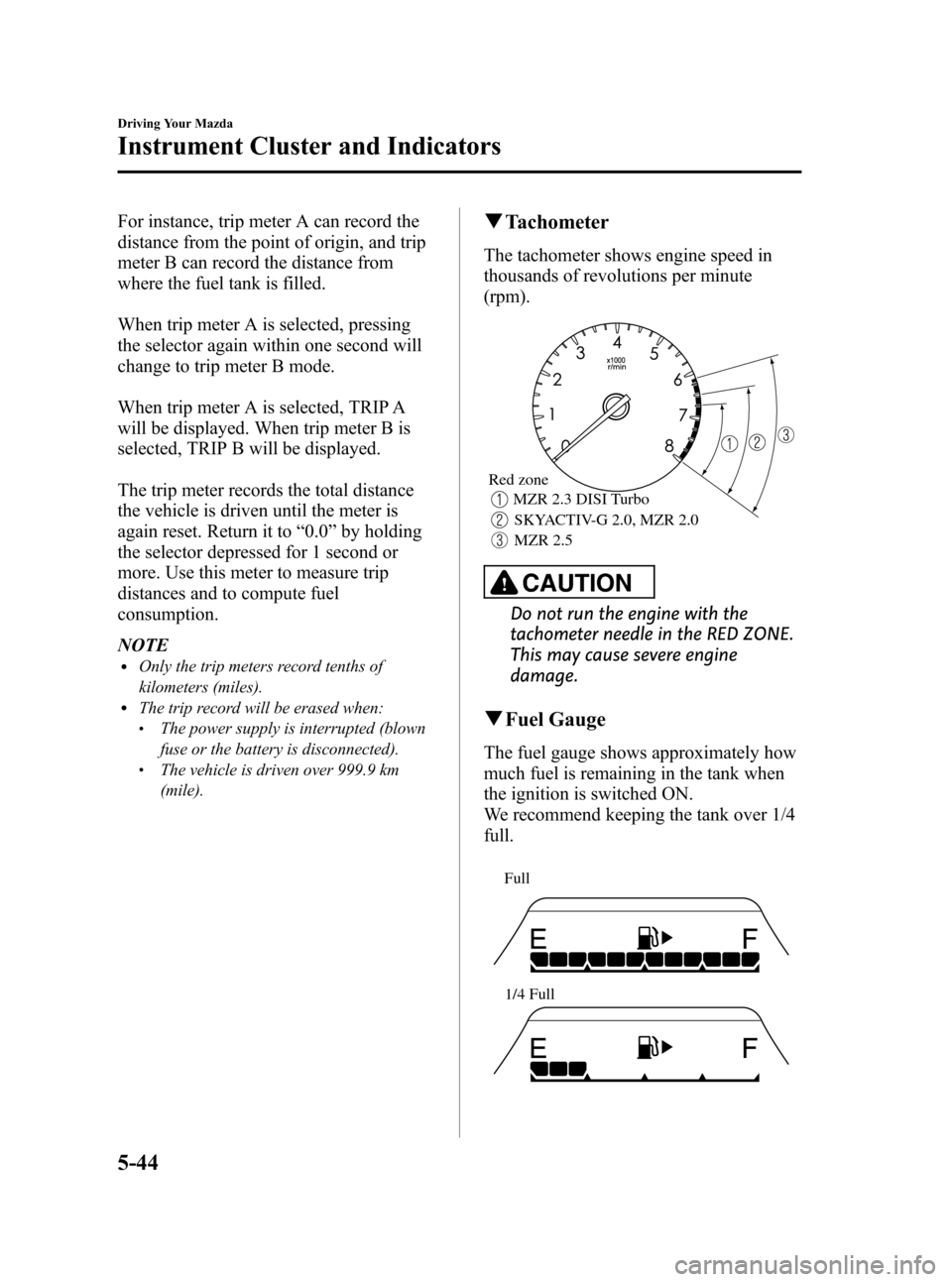
Black plate (206,1)
For instance, trip meter A can record the
distance from the point of origin, and trip
meter B can record the distance from
where the fuel tank is filled.
When trip meter A is selected, pressing
the selector again within one second will
change to trip meter B mode.
When trip meter A is selected, TRIP A
will be displayed. When trip meter B is
selected, TRIP B will be displayed.
The trip meter records the total distance
the vehicle is driven until the meter is
again reset. Return it to“0.0 ”by holding
the selector depressed for 1 second or
more. Use this meter to measure trip
distances and to compute fuel
consumption.
NOTE
lOnly the trip meters record tenths of
kilometers (miles).
lThe trip record will be erased when:lThe power supply is interrupted (blown
fuse or the battery is disconnected).
lThe vehicle is driven over 999.9 km
(mile).
q Tachometer
The tachometer shows engine speed in
thousands of revolutions per minute
(rpm).
SKYACTIV-G 2.0, MZR 2.0
MZR 2.5
MZR 2.3 DISI Turbo
Red zone
CAUTION
Do not run the engine with the
tachometer needle in the RED ZONE.
This may cause severe engine
damage.
q
Fuel Gauge
The fuel gauge shows approximately how
much fuel is remaining in the tank when
the ignition is switched ON.
We recommend keeping the tank over 1/4
full.
Full
1/4 Full
5-44
Driving Your Mazda
Instrument Cluster and Indicators
Mazda3_8BY7-EC-11F_Edition1 Page206
Friday, June 17 2011 2:55 PM
Form No.8BY7-EC-11F
Page 217 of 525
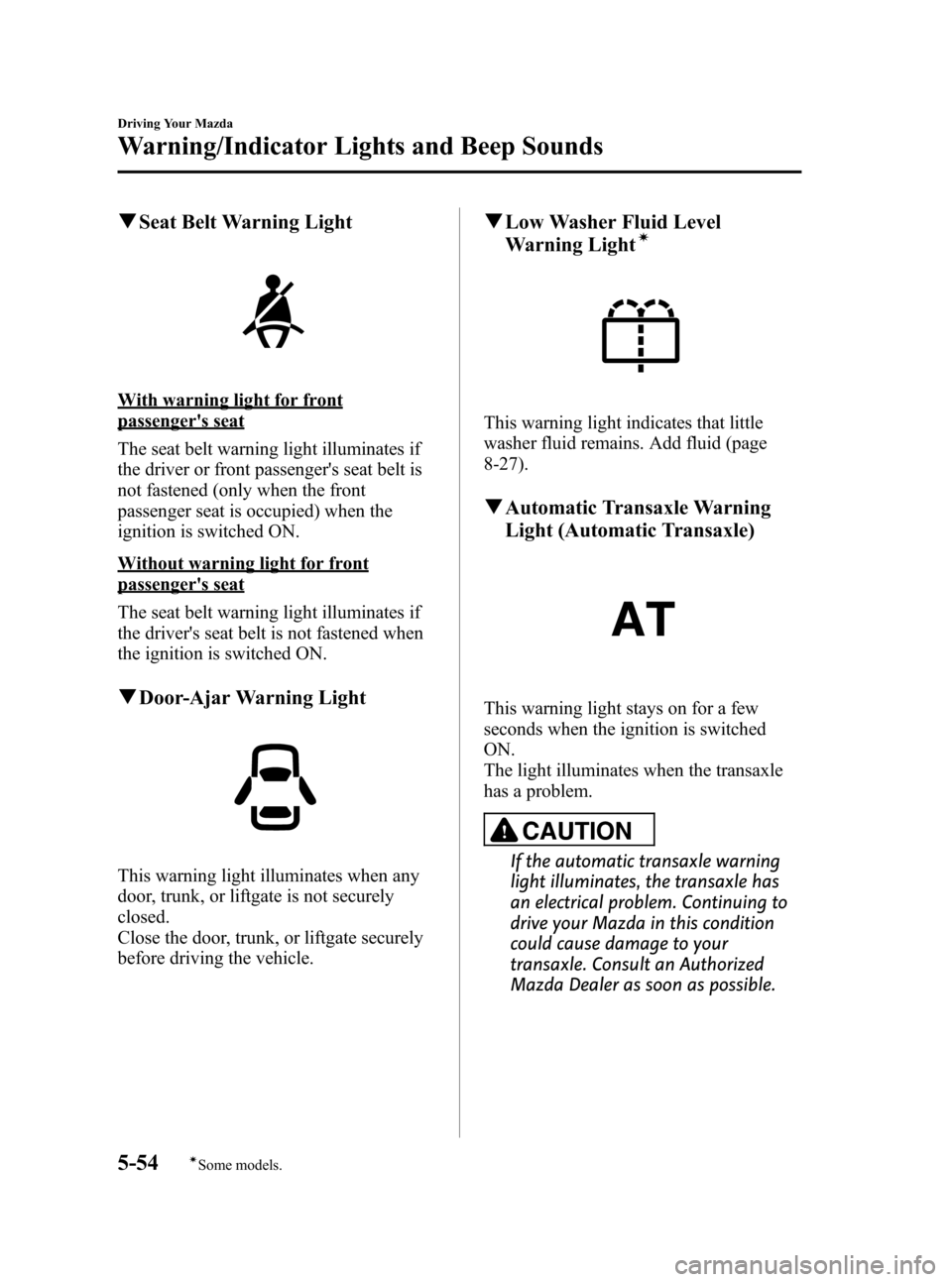
Black plate (216,1)
qSeat Belt Warning Light
With warning light for front
passenger's seat
The seat belt warning light illuminates if
the driver or front passenger's seat belt is
not fastened (only when the front
passenger seat is occupied) when the
ignition is switched ON.
Without warning light for front
passenger's seat
The seat belt warning light illuminates if
the driver's seat belt is not fastened when
the ignition is switched ON.
qDoor-Ajar Warning Light
This warning light illuminates when any
door, trunk, or liftgate is not securely
closed.
Close the door, trunk, or liftgate securely
before driving the vehicle.
qLow Washer Fluid Level
Warning Lightí
This warning light indicates that little
washer fluid remains. Add fluid (page
8-27).
qAutomatic Transaxle Warning
Light (Automatic Transaxle)
This warning light stays on for a few
seconds when the ignition is switched
ON.
The light illuminates when the transaxle
has a problem.
CAUTION
If the automatic transaxle warning
light illuminates, the transaxle has
an electrical problem. Continuing to
drive your Mazda in this condition
could cause damage to your
transaxle. Consult an Authorized
Mazda Dealer as soon as possible.
5-54
Driving Your Mazda
íSome models.
Warning/Indicator Lights and Beep Sounds
Mazda3_8BY7-EC-11F_Edition1 Page216
Friday, June 17 2011 2:55 PM
Form No.8BY7-EC-11F